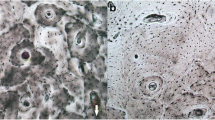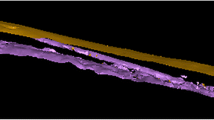Abstract
Anthropologists are frequently required to confirm or exclude the human origin of skeletal remains; DNA and protein radioimmunoassays are useful in confirming the human origin of bone fragments but are not always successful. Histology may be the solution, but the young subadult structure could create misinterpretation. Histological tests were conducted on femur and skull of 31 human subjects. Each sample was observed focusing on presence or absence of fibrous bone, lamellar bone, radial lamellar bone, plexiform bone, reticular pattern, osteon banding, Haversian bone, primary osteons, secondary osteon and osteon fragments. Samples were divided into five age classes; 1 (<1 year), 2 (1–5 years), 3 (6–10 years), 4 (11–15 years) and 5 (16–20 years). Regarding femurs, class 1 presented the following: 87.5 % fibrous bone, 37.5 % plexiform bone, 12.5 % reticular pattern and 12.5 % lamellar bone radially oriented. Class 2 showed 37.5 % of fibrous bone, 12.5 % of reticular pattern and 37.5 % of osteon banding. In the higher age classes, the classical human structures, lamellar bone and osteons were frequently visible, except for one case of reticular pattern, generally considered a distinctive non-human structure. The situation appeared different for the skull, where there was a lack of similar information, both in human and non-human. An analysis of the percentage of lamellar bone and osteons was conducted on femur and skull fragments. A trend of increase of primary osteon number and a decrease of the lamellar bone area has been detected in the femur. The present study has therefore shed some light on further pitfalls in species determination of subadult bone.












Similar content being viewed by others
References
Lowenstein LM, Reuther JD, Hood DG, Scheuenstuhl G, Gerlach SC, Ubelaker DH (2005) Identification of animal species by protein radioimmunoassay of bone fragments and bloodstained stone tools. Forensic Sci Int 159:182–188. doi:10.1016/j.forsciint.2005.08.007
Götherström A, Collins MJ, Angerbjörn A, Lidén K (2002) Bone preservation and DNA amplification. Archaeometry 44:395–404. doi:10.1111/1475-4754.00072
Graw M, Weisser HJ, Lutz S (2000) DNA typing of human remains found in damp environments. Forensic Sci Int 113:91–95. doi:10.1016/S0379-0738(00)00221-8
Nelson K, Melton T (2007) Forensic mitochondrial DNA analysis of 116 casework skeletal samples. J Forensic Sci 52:557–561. doi:10.1111/j.1556-4029.2007.00407.x
Steadman DW, DiAntonio LL, Wilson JJ, Sheridan KE, Tammariello SP (2006) The effects of chemical and heat maceration techniques on the recovery of nuclear and mitochondrial DNA from bone. J Forensic Sci 51:11–17. doi:10.1111/j.1556-4029.2005.00001.x
Cattaneo C (2007) Forensic anthropology: developments of a classical discipline in the new millennium. Forensic Sci Int 165:185–193. doi:10.1016/j.forsciint.2006.05.018
Cattaneo C, Di Martino S, Scali S, Craig OE, Grandi M, Sokol RJ (1999) Determining the human origin of fragments of burnt bone: a comparative study of histological, immunological and DNA techniques. J Forensic Sci 102(2-3):181–191. doi:10.1016/S0379-0738(99)00059-6
Gonçalves D (2012) The micro-analysis of human burned bones: some remarks. Cadernos do GEEvH 1(1):32–40
Harbeck M, Schleuder R, Schneider J, Wiechmann I, Schmahl WW, Grupe G (2011) Research potential and limitations of trace analyses of cremated remains. Forensic Sci Int 204(1):191–200. doi:10.1016/j.forsciint.2010.06.004
Schwark T, Heinrich A, Preuße-Prange A, von Wurmb-Schwark N (2011) Reliable genetic identification of burnt human remains. Forensic Sci Int Genet 5:393–399. doi:10.1016/j.fsigen.2010.08.008
Tsuchimochi T, Iwasa M, Maeno Y, Koyama H, Inoue H, Isobe I, … & Nagao M (2002) Chelating resin-based extraction of DNA from dental pulp and sex determination from incinerated teeth with Y-chromosomal alphoid repeat and short tandem repeats. Am J Forensic Med Pathol 23(3):268-271. doi: 10.1097/01.PAF.0000022965.64141.61
Ubelaker DH (2009) The forensic evaluation of burned skeletal remains: a synthesis. Forensic Sci Int 183(1):1–5. doi:10.1016/j.forsciint.2008.09.019
Hillier ML, Bell LS (2007) Differentiating human bone from animal bone: a review of histological methods. J Forensic Sci 52(2):249–263. doi:10.1111/j.1556-4029.2006.00368.x
Sawada J, Nara T, Fukui J, Dodo Y, Hirata K (2014) Histomorphological species identification of tiny bone fragments from a paleolithic site in the northern Japanese archipelago. J Archeol Sci 46:270–280
Cattaneo C, Porta D, Gibelli D, Gamba C (2009) Histological determination of human origin of bone fragments. J Forensic Sci 54(3):531–533. doi:10.1111/j.1556-4029.2009.01000.x
Crescimanno A, Stout SD (2012) Differentiating fragmented human and nonhuman long bone using osteon circularity. J Forensic Sci 57(2):287–294. doi:10.1111/j.1556-4029.2011.01973.x
Dominguez VM, Crowder CM (2012) The utility of osteon shape and circularity for differentiating human and non-human Haversian bone. Am J Phys Anthropol 149(1):84–91. doi:10.1002/ajpa.22097
Martiniaková M, Grosskopf B, Omelka R, Vondraková M, Bauerová M (2006) Differences among species in compact bone tissue microstructure of mammalian skeleton: use of a discriminant function analysis for species identification. J Forensic Sci 51(6):1235–1239. doi:10.1111/j.1556-4029.2006.00260.x
Zoetis T, Tassinari MS, Bagi C, Walthall K, Hurtt ME (2003) Species comparison of postnatal bone growth and development. Birth Defects Res B Dev Reprod Toxicol 68(2):86–110. doi:10.1002/bdrb.10012
Mori R, Kodaka T, Soeta S, Sato J, Kakino J, Hamato S, Takaki H, Naito Y (2005) Preliminary study of histological comparison on the growth patterns of long-bone cortex in young calf, pig and sheep. J Vet Sci 67(12):1223–1229. doi:10.1292/jvms.67.1223
Feng L, Jasiuk I (2011) Multi-scale characterization of swine femoral cortical bone. J Biomech 44(2):313–320. doi:10.1016/j.jbiomech.2010.10.011
Manilay Z, Novitskaya E, Sadovnikov E, McKittrick J (2013) A comparative study of young and mature bovine cortical bone. Acta Biomater 9(2):5280–5288. doi:10.1016/j.actbio.2012.08.040
Rauch F, Travers R, Glorieux FH (2007) Intracortical remodeling during human bone development—a histomorphometric study. Bone 40(2):274–280. doi:10.1016/j.bone.2006.09.012
Goldman HM, McFarlin SC, Cooper DML, Thomas CDL, Clement JG (2009) Ontogenetic patterning of cortical bone microstructure and geometry at the human mid-shaft femur. Anatomical Rec 292(1):48–64. doi:10.1002/ar.20778
Cuijpers SA (2009) Distinguishing between the bone fragments of medium-sized mammals and children. A histological identification method for archaeology. Anthrop Anz 67(2):181–203. doi:10.1127/0003-5548/2009/0021
Cuijpers SA (2006) Histological identification of bone fragments in archaeology. Telling humans apart from horses and cattle. Int J Osteoarchaeol 16:465–480. doi:10.1002/oa.848
Mulhern DM, Ubelaker DH (2001) Differences in osteon banding between human and nonhuman bone. J Forensic Sci 46(2):220–222
DL Kasper, E Braunwald, AS Fauci, SL Hauser, DL Longo, JL Jameson (2007) “Harrison. Principi di Medicina Interna”
Scheuer L, Black S, Christie A (2000) Developmental juvenile osteology. Academic Press, San Diego
Ontanon M, Aparicio C, Ginebra MP, Planell JA (2000) Structure and mechanical properties of cortical bone. In: Elices M (ed) Structural biological materials. Pergamon, Amsterdam, pp 33–71
Brits D, Steyn M, L’Abbé EN (2014) A histomorphological analysis of human and non-human femora. Int J Legal Med 128(2):369–377. doi:10.1007/s00414-013-0854-3
Robling AG, Stout SD (2000) Histomorphometry of human cortical bone: applications to age estimation. In: Katzengerg MA, Saunders SR (eds) Biological anthropology of the human skeleton. Wiley-Liss, Inc., New York, pp 187–213
Dixon RA, Dawson L, Taylor D (2008) The experimental degradation of archaeological human bone by anaerobic bacteria and the implications for recovery of ancient DNA. The 9th International Conference on Ancient DNA and Associated Biomolecules
Garland AN (1988) A histological study of archaeological bone decomposition. Manchester University Press 109–126
Hackett CJ (1981) Microscopical focal destruction (tunnels) in excavated human bones. Med Sci Law 21:243–265. doi:10.1177/002580248102100403
Jeans MME, Nielsen-Marsh CM, Smith CI, Collins MJ, Kars H (2004) Characterisation of microbial attack on archeological bone. J Archeol Sci 31:87–95. doi:10.1016/j.jas.2003.07.007
De Ricqles AJ (1974) Evolution of endothermy histological evidence. Evol Theory 1(2):51–80
Locke M (2004) Structure of long bones in mammals. J Morphol 262:546–565. doi:10.1002/jmor.10282
Cool SM, Hendrikz JK, Wood WB (1995) Microscopic age changes in the human occipital bones. J Forensic Sci 40(5):789–796
Author information
Authors and Affiliations
Corresponding author
Rights and permissions
About this article
Cite this article
Caccia, G., Magli, F., Tagi, V.M. et al. Histological determination of the human origin from dry bone: a cautionary note for subadults. Int J Legal Med 130, 299–307 (2016). https://doi.org/10.1007/s00414-015-1271-6
Received:
Accepted:
Published:
Issue Date:
DOI: https://doi.org/10.1007/s00414-015-1271-6




